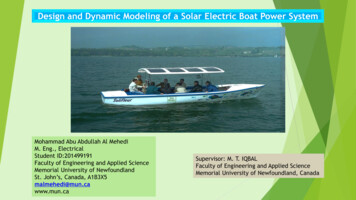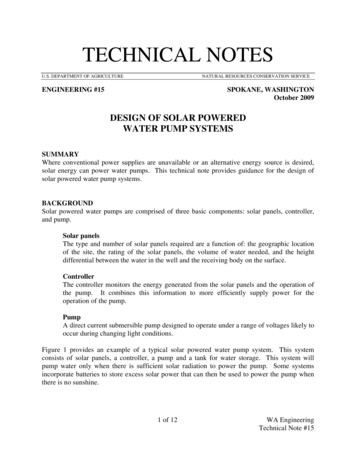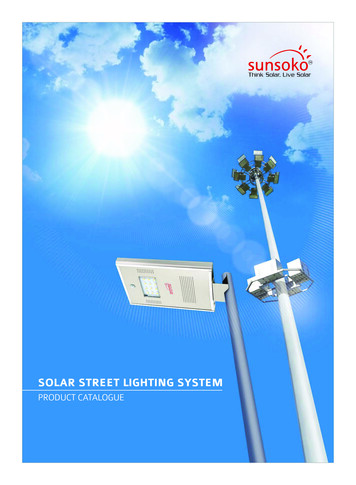
Transcription
Power System Studies forSolar and Wind FarmsMinnesota Power Systems Conference November 3rd, 2020Ahmad Abdullah, PhD, PE, SMIEEECurtis Roe, PhDMortenson Engineering Services, Inc.700 Meadow Lane NorthMinneapolis, MN 55422Mortenson Let’s Redefine Possible www.mortenson.com/Engineering
SummaryThe presentation will center around how the interconnection ofa wind or solar farm will affect the design of a substation. It willdiscuss: Surge arrester and neutral grounding reactor sizing in relation to thecollection system cable concentric neutrals. Main Power Transformer sizing with respect to the reactive powerrequirements. Choosing between DETC/OLTC: Substation voltage operating range DETC/OLTC tap selection: How it affects the collection system2Power System Studies for Solar and Wind Farms
Outline Mortenson & Mortenson Engineering Services Mortenson Studies Overview Studies Outline: Reactive Power Short Circuit Transient Overvoltage (TOV)3Power System Studies for Solar and Wind Farms
4Power System Studies for Solar and Wind Farms
5Power System Studies for Solar and Wind Farms
Mortenson Engineering ServicesMortenson’s Fully Integrated Engineering Solution Supports our Power Customers from Conceptthrough Operations and Maintenance 6Concept and Developmento Our team leverages construction expertise to eliminate project return uncertainty.Designo Our Engineers carry through as the EOR, ensuring system performance and cost are optimized through the designphase.Constructiono The Engineers remain with the project to minimize uncertainty and work with project teams to ensure safest and bestvalue delivery.Commissioningo Our commissioning Engineers engage early in design to ensure facility energization is completed within schedule,with no issues.Operations and Maintenanceo We work hand in hand with Mortenson and customer O&M teams to minimize lifecycle costs during design andsupport long-term lowest cost operation.Power System Studies for Solar and Wind Farms
Mortenson Studies OverviewStudyDeliverableShort CircuitFault current used for equipment sizingLossesMaximum collection losses (contractual value of 2.5%)Reactive PowerCapacitor bank sizing and transformer tap settingsTransient Over Voltage &Effective GroundingSurge arrestor sizing, Current limiting reactors, Circuit breakerratings, Critical fault clearing timesHarmonicsCapacitor bank step size, Harmonic filters, IEEE 519Arc FlashPersonal Protective EquipmentNERC PRCsGenerator Voltage and Frequency Ride-through Settings7Power System Studies for Solar and Wind FarmsToolPSSEPSCADETAPPSSE
Reactive Power Study The objective of the study is to:oSize capacitor banks or reactor banks to meet the power factor (PF) requirement§ oDetermine on-load tap changer (OLTC) or deenergized tap changer (DETC) setting of all transformersoEnsure the voltage across the collection system and inverter/turbine terminals is within acceptable limits (generally10%)oDetermine the top rating of the main power transformer (MPT)oReport the P-Q capability of the project (at high side or POI depending on PF requirement)The objectives are interrelated:oThe OLTC set point has a high impact on capacitor bank size§8generally 0.95 PF at the POI, sometimes 0.95 at high side bus for the voltage range specified by TSPsince 𝑄 𝑉 !, if we choose to set the OLTC at 1.05 tap, then 10% less capacitor bank size is requiredoThe OLTC set point affects the voltage across the collection systemoThe Capacitor bank determines top rating of the MPToThe study is completely decoupled from the short circuit and TOV studiesPower System Studies for Solar and Wind Farms
Leading LaggingReactive Power Study9Power System Studies for Solar and Wind FarmsP [MW]Q [MVAr]A0.201.0B1.411.0E1.75-1.0F0.20-1.0P [MW]Q [MVAr]C Δ 0.05pu2.20.723C Δ 0.1pu2.20.210D Δ 0.05pu2.2-0.723D Δ 0.1pu2.2-0.204
Reactive Power – MPT with OLTC 10Two cases are needed to determine Capacitor Bank sizing:oLowest POI Voltage:§ Generally 0.95 Vpu§ Set inverters/turbines to produce maximum reactive power§ Add capacitors to banks to meet 0.95 PF at POI§ The OLTC is generally set to raise the voltage across collection system to its highest level possible in order todetermine the minimum capacitor bank size.oMax POI Voltage§ Generally 1.05 Vpu§ Set inverters/turbines to produce maximum reactive power Virtually all power plant controllers request dynamic MVArs before requesting capacitor bank MVArs§ Determine if there is an MPT tap that would bring the low side voltage as stated above. If not, change capacitorbank size and repeat the first case. Generally there is no need to adjust the capacitor bank size and the lowside voltage above is the OLTC set point.The procedure is complicated if the turbines have reactive power capability that is voltage dependent:o Only happens with wind turbines and not solar inverterso In general, solar inverters do not derate for voltage going above 1 Vpu but derate if voltage goes below 1 Vpu.o We never saw a terminal voltage less than 1 Vpu in the case of supplying reactive power. This makes analysis easier.Power System Studies for Solar and Wind Farms
Reactive Power – MPT with DETC This approach is more complex as the ability to regulate the low side bus is lost and the DETC of the turbine transformers(PMT’s) need tuning as well. However the main idea is similar in that capacitor banks need to be sized based on thelowest voltage possible:o Lowest POI Voltage:§ Generally 0.95 Vpu§ Set inverters/turbines to produce maximum reactive power§ Add capacitors to banks to meet 0.95 PF at POI§ Set the DETC to the appropriate level to lower the voltage across collection systemo 11Max POI Voltage:§ Generally 1.05 Vpu§ Set inverters/turbines to produce maximum reactive power§ Determine if there is an MPT tap that would bring the low side voltage as stated above to normal limits. If not,start adjusting the DETCs of the turbines/inverters to bring the voltage down. Generally the DETC of the MPTwouldn’t be adjusted unless voltage on the 34.5 kV side is very high.This will be an iterative process to select the minimum capacitor bank size and the best DETC settings. The MPT DETCsetting will also depend on the leading power factor cases, which complicates the iterative process.Power System Studies for Solar and Wind Farms
Min Terminal Voltage [pu]Max Terminal Voltage [pu]Min Collection Voltage [pu]Max Collection Voltage [pu]-72.072-161.13461.16171.16921.13461.14230.95 -150.039-49.214160.93880.97080.97950.93880.948MPT has DETC0.916 23 29 -150.375-60.11301.02741.0571.06511.02741.03590.934 -150.294-57.28511.00371.03391.04221.00371.01230.94 -150.229-54.54520.98111.01191.02030.98110.9899POI PF12Power System Studies for Solar and Wind FarmsTap Position0.902 -150.672POI Reactive Power [MVAr]MPT has OLTCPOI Voltage 0.95 Vpu100% DispatchPOI Real Power [MW]Substation Voltage [pu]Reactive Power Study
Short Circuit Objective:13oEnsure that three phase (3Ph) faults are within the cable conductor withstand capabilityoSize the substation switchgearoSize the neutral ground reactor at the X0 bushing of the MPT to ensure that the SLG faults are within cableconcentric neutrals withstand capabilityPower System Studies for Solar and Wind Farms
Short Circuit Three Phase Faults (3ph)oThe only way to control 3ph faults is either by installing line reactors (expensive) or getting a high impedance MPToLine reactors are always avoided due to TRV issuesoA high impedance MPT is not always an option since the Owner typically purchases the MPT most of the time. A highimpedance MPT also acts like a line reactor, which is not preferableoIf high 3ph faults are identified, the only realistic solution is to have a larger cable cross section, which is naturallythe case because the cable homerun is generally large ( 1250 kcmil) due to ampacity requirements.oNever had issues with 3ph faults (typical numbers on next slide)Single Line to ground faults (SLG)14oThe cable concentric neutrals are given from the bid/proposal (can be dictated by the Owner)oAcross the industry, there is trend of using the smallest cable concentric neutral possible to save costoThe NGR becomes the only tool to control the SLG fault current at the low side of the MPTPower System Studies for Solar and Wind Farms
Typical Cable withstand Clearly, 3ph fault currents are not an issue except for 1/0 Increasing the coordination time and accounting for a breaker failure scenariowould cause the withstand to drop (30% drop for 16 cycles)15Power System Studies for Solar and Wind Farms
The NGR TheNGR size plays an exceedingly important role during SLG faults Thevoltage rise across the collection system is a direct function in the NGR size Generalpractice is to size the NGR to keep the system effectively grounded (The phase voltageshould not be more than 1.39 Vpu during fault conditions) Sometimes16designing an effectively grounded system is not possible:oOnce a SLG fault happens, the current splits between the cable concentric neutral, trench ground, and earthoThere is no industry standard on the split factor of ground currents in undergrounded systems. Designs mustassume that 100% of the fault current will be flowing in the cable concentric neutral.Power System Studies for Solar and Wind Farms
TOV Various17scenarios are studied:oWorst case capacitor switching: Occurs at peak voltage.oSurge arresters: Conduction needs to be monitored. This is generally not a big deal (switching frequency is generallyaround 700 Hz and lasts for less than a cycle).oWorst case faults: This is a single line to ground fault downstream of the feeder breaker. This fault causes maximumvoltage rise across collection system at the end of the collection circuit. Also, surge arrester conduction is monitored.Generally a very big deal and will be described next slide.oLoad rejection: This is important for wind farms as turbines continue to produce power after a feeder is isolated.Generally less severe than SLG faults.oEnergization: Make sure that no saturation occurs. Generally not a big deal.Power System Studies for Solar and Wind Farms
TOV and NGR size During a SLG fault, the voltage rise is a function of the NGR size. If the system can not be designed to be effectively grounded, the surge arrester will be in conduction mode during SLGfault conditions. 18If the NGR size can not change, the protective relay tripping times must be made faster (decreased).Once the feeder breaker opens, the feeder becomes islanded or groundedoThe feeder may be grounded if grounding breakers or grounding transformers are usedoIf not (which is becoming more normal for solar designs), severe voltage rise occurs and a detailed investigationneeds to be undertaken to ensure that the system surge arresters will not be damaged.oGenerally, faster tripping times would solve the problem (Note: Faster tripping times can cause miscoordinationbetween the wind turbine switchgear and the substation protective relays).Power System Studies for Solar and Wind Farms
Example of a non-effectively grounded system19Power System Studies for Solar and Wind Farms
Summary Thetop MVA rating of the MPT comes out the reactive power study. It corresponds to the 100%MW output while meeting the PF lagging (project supplying MVArs) requirement. TheOLTC of the MPT plays a major role in wind and solar plant operation. For large projects, PFrequirements can’t be attained with a DETC due to voltage limitations in collection system. TheNGR size determines whether the system is effectively grounded and is generally driven bythe economics of the project. TheNGR size can have implications for the system surge arrester size. A moderate violation isgenerally tolerable. SLGfaults, cable concentric neutral size, NGR size, relay coordination, and surge arresters gohand in hand.20Power System Studies for Solar and Wind Farms
QUESTIONS?21Power System Studies for Solar and Wind Farms
2 Power System Studies for Solar and Wind Farms Summary The presentation will center around how the interconnection of a wind or solar farm will affect the design of a substation. It will discuss: Surge arrester and neutral grounding reactor sizing in relation to the coll










